Overview
Electronics is the science of dealing with the development and application of devices and systems involving the flow of electrons in a vacuum, in gaseous media, and in semiconductors. Electronics deals with electrical circuits that involve active electrical components such as vacuum tubes, transistors, diodes, integrated circuits, optoelectronics, and sensors, associated passive electrical components, and interconnection technologies. Commonly, electronic devices contain circuitry consisting primarily or exclusively of active semiconductors supplemented with passive elements; such a circuit is described as an electronic circuit.
The science of electronics is considered to be a branch of physics and electrical engineering. The nonlinear behavior of active components and their ability to control electron flows makes amplification of weak signals possible. Electronics is widely used in information processing, telecommunication, and signal processing. The ability of electronic devices to act as switches makes digital information processing possible. Interconnection technologies such as circuit boards, electronics packaging technology, and other varied forms of communication infrastructure complete circuit functionality and transform the mixed components into a regular working system.
Electrical and electro-mechanical science and technology deals with the generation, distribution, switching, storage, and conversion of electrical energy to and from other energy forms (using wires, motors, generators, batteries, switches, relays, transformers, resistors, and other passive components). This distinction started around 1906 with the invention by Lee De Forest of the triode, which made electrical amplification of weak radio signals and audio signals possible with a non-mechanical device. Until 1950 this field was called "radio technology" because its principal application was the design and theory of radio transmitters, receivers, and vacuum tubes.
Today, most electronic devices use semiconductor components to perform electron control. The study of semiconductor devices and related technology is considered a branch of solid-state physics, whereas the design and construction of electronic circuits to solve practical problems come under electronics engineering. This article focuses on engineering aspects of electronics.
Electronic Versus Electrical
In 1893, Alan MacMaster invented the first electric toaster in Edinburgh, Scotland. The heating elements in a toaster turn electrical energy into heat so you can burn your toast. Herein lies the distinction between electric and electronic devices—the manipulation of energy in technology.
Electrical devices take the energy of electrical current, the flow of electrons in a conductor, and transform it in simple ways into some other form of energy—most likely light, heat, or motion. An electric device is one that directly uses electrical energy to perform a task.
In contrast, electronic devices do much more. Instead of just converting electrical energy into light, heat, or motion, electronic devices are designed to manipulate the electrical current in ways that adds meaningful information to the current.
For example, an electronic toaster uses the same heating elements, springs, and bread racks as an electric toaster, but may include a variety of more complex components such as an electronic display panel that shows you the progress of your toasting, or an electronic thermostat that attempts to keep the heat at just the right temperature. Electronics refers to technology that works by controlling the motion of electrons in ways that go beyond electrodynamic properties like voltage and current.
Integrated Circuits
The integrated circuit is nothing more than a very advanced electric circuit. An electric circuit is made from different electrical components such as transistors, resistors, capacitors and diodes, that are connected to each other in different ways. These components have different behaviors.
- The transistor acts like a switch. It can turn electricity on or off, or it can amplify current. It is used for example in computers to store information, or in stereo amplifiers to make the sound signal stronger.
- The resistor limits the flow of electricity and gives us the possibility to control the amount of current that is allowed to pass. Resistors are used, among other things, to control the volume in television sets or radios.
- The capacitor collects electricity and releases it all in one quick burst; like for instance in cameras where a tiny battery can provide enough energy to fire the flashbulb.
- The diode stops electricity under some conditions and allows it to pass only when these conditions change. This is used in, for example, photocells where a light beam that is broken triggers the diode to stop electricity from flowing through it.
These components are like the building blocks in an electrical construction kit. Depending on how the components are put together when building the circuit, everything from a burglar alarm to a computer microprocessor can be constructed.
Important Documents Related To Semiconductors and Computers
The First Computing Devices
- Unknown: The Abacus (manually operated). Abacuses still remain in use in some countries.
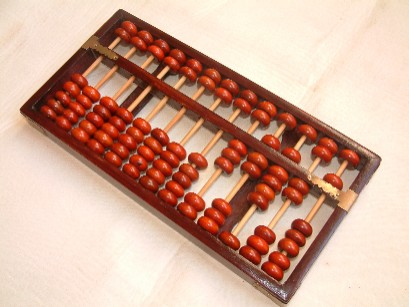 Abacus
Abacus
- 1847: Babbage's Difference Engine (mechanically operated).
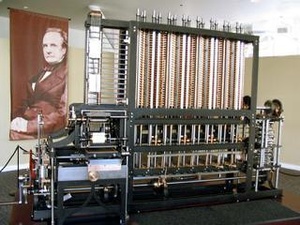 Babbage Difference Engine.
Babbage Difference Engine.
- It's not until nearly 100 years later that electronic computing machines are invented. For an extensive listing of the chronology of the first computers, see https://historycooperative.org/first-computer/.
Timeline of Events Leading Up To The First Personal Computers
These notes were pulled from the FFH video Silicon Valley A 100 Year Renaissance, the PBS video Silicon Valley Where The Future Was Born, and the book The Chip, How Two Americans Invented The Microchip & Launched a Revolution, by T. R. Reid.
- 1891 (Oct.): Standford University opens
- Leland Stanford, U.S Senator, California's Civil War Governor, President of the Central Pacific railroad, donated 880,000 acres in Santa Clara Valley, CA and a $20 million endowment in honor of their son, Leland Jr.
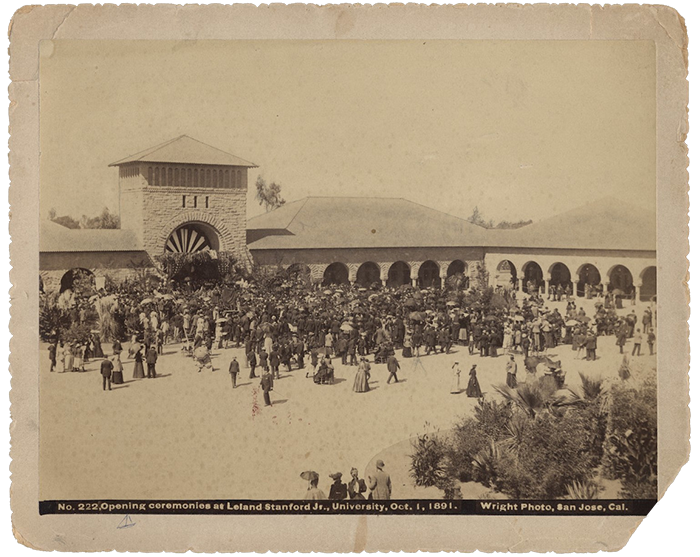 Opening ceremonies at Leland Standford Jr. University, Oct. 1, 1891. Wright Photo, San Jose Cal. Standford University 1891.
Opening ceremonies at Leland Standford Jr. University, Oct. 1, 1891. Wright Photo, San Jose Cal. Standford University 1891.
- 1913: Magnavox (Latin for "great voice") founded in Napa, CA in 1911, moves to San Francisco.
- 1931: A. H. Wilson publishes research entitled The Theory of Electronic Semi-Conductors which William Shockley uses as a basis for his work on the transistor.
- 1935: William Hewlett and David Packard graduated from Stanford with degrees in electrical engineering from Stanford University.
- 1935: Radar invented by Robert Watson and Arnold Wilkens in Britain.
- 1937: Klystron invented by Russell and Sugurd Varian who start Varian Associates and move to SRI in 1954.
- 1938: Hewlett/Packard begin part-time work in rented garage with an initial capital investment of $538.00 provided by Stanford professors with encouragement from Standford professor and H/P mentor Frederick Terman. H/P initially produced a line of electronic test equipment.
- 1939: Hewlett and Packard decide to formalize their partnership and start a new company culture that includes profit sharing for employees.
- 1939: Audio oscillator invented by Hewlett/Packard.
- 1939: WWII creates need for smaller electronics components to be used in planes and missiles.
- 1941: Klystron implemented in war planes giving American WWII planes ability to seek and destroy German u-boats (submarines).
- 1943-1945: Colossus - First programmable, electronic digital computer (located in Britain's Blecthley Park). Used thermionic valves (vacuum tubes) to perform Boolean and counting operations.
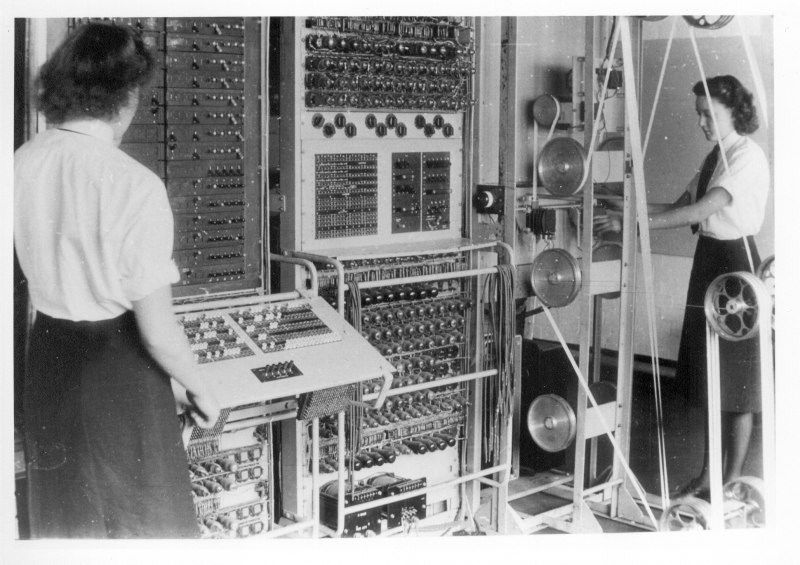 Colossus in operation at Bletchley Park.
Colossus in operation at Bletchley Park.
- 1944: The IBM Automatic Sequence Controlled Calculator (ASCC), called Mark I by Harvard University’s staff, was a general purpose electromechanical computer that was used in the war effort during the last part of World War II.
One of the first programs to run on the Mark I was initiated on 29 March 1944 by John von Neumann. At that time, von Neumann was working on the Manhattan project, and needed to determine whether implosion was a viable choice to detonate the atomic bomb that would be used a year later. The Mark I also computed and printed mathematical tables, which had been the initial goal of British inventor Charles Babbage for his "analytical engine".
The Mark I was disassembled in 1959, but portions of it are displayed in the Science Center as part of the Harvard Collection of Historical Scientific Instruments. Other sections of the original machine were transferred to IBM and the Smithsonian Institution.
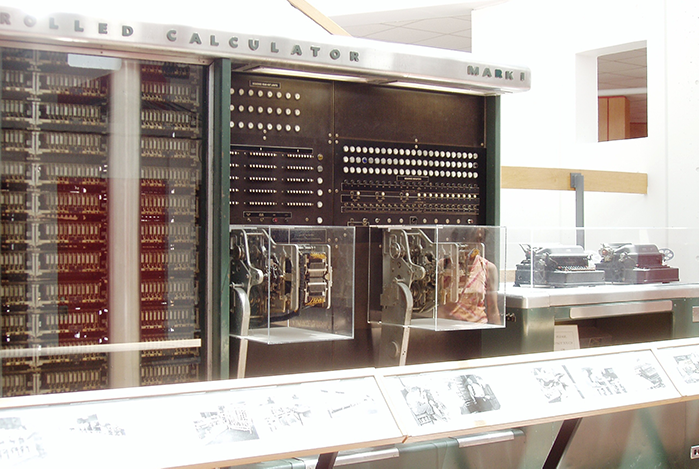 The right end of the IBM Automatic Controlled Calculator (a.k.a. Harvard Mark I).
The right end of the IBM Automatic Controlled Calculator (a.k.a. Harvard Mark I).
- 1946: (Feb. 15) Eniac, the electronic numerical integrator and computer, was amongst the earliest electronic general purpose computers made. The first digital computer according to NobelPrize.org.
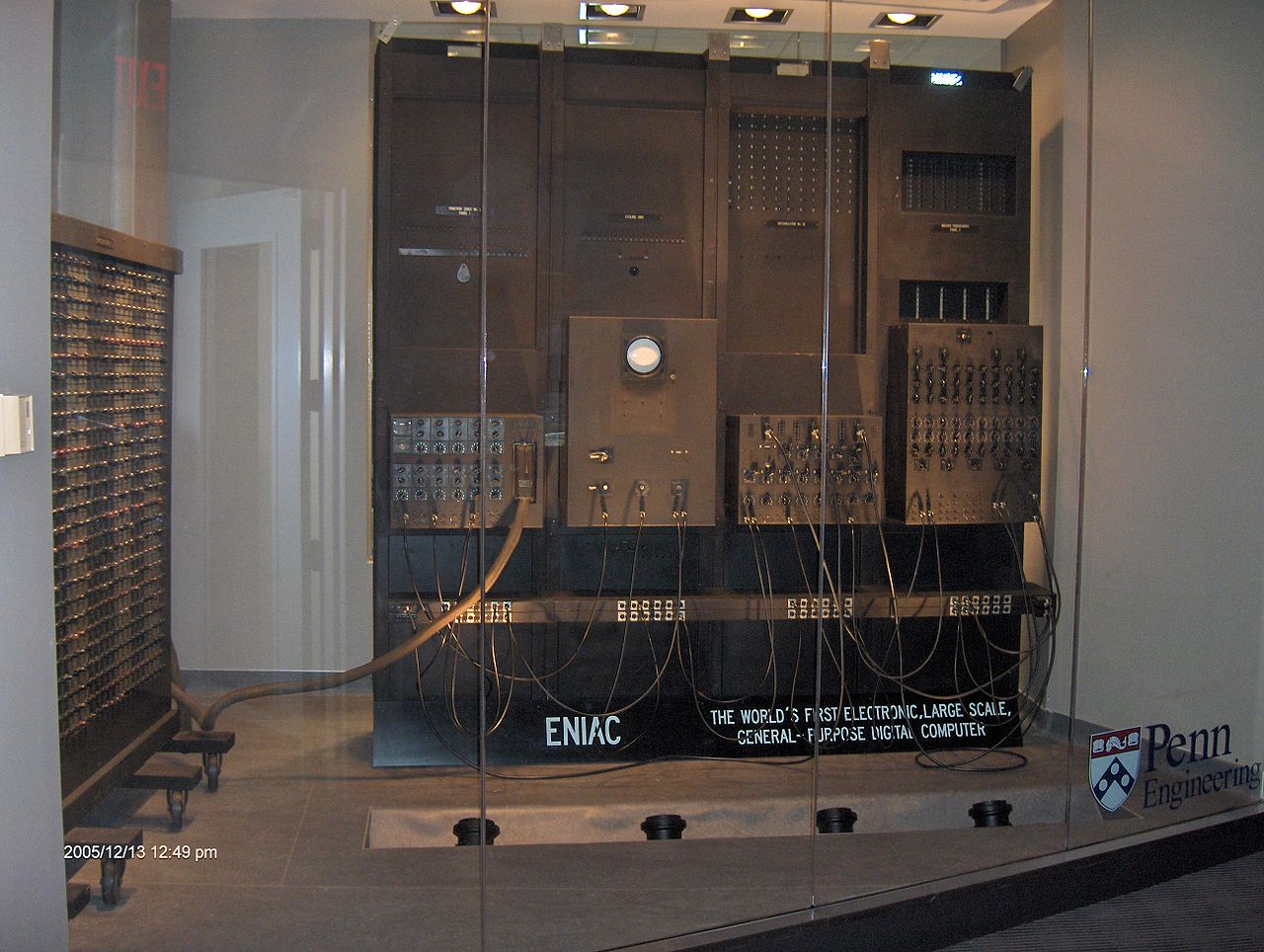 By The original uploader was TexasDex at English Wikipedia - Transferred from en.wikipedia to Commons by Andrei Stroe using CommonsHelper., CC BY-SA 3.0, Link
By The original uploader was TexasDex at English Wikipedia - Transferred from en.wikipedia to Commons by Andrei Stroe using CommonsHelper., CC BY-SA 3.0, Link
- 1946: Standford University forms non-profit research institute, the Stanford Research Institute (SRI), as a center of innovation to support economic development in the region.
- 1947: The transistor invented by Bill Shockley, John Bardeen, and Walter Houser Brattain of Bell Labs, announced at a press conference in New York city on June 30,1948.Principle of proof was obtained on April 7, 1949.
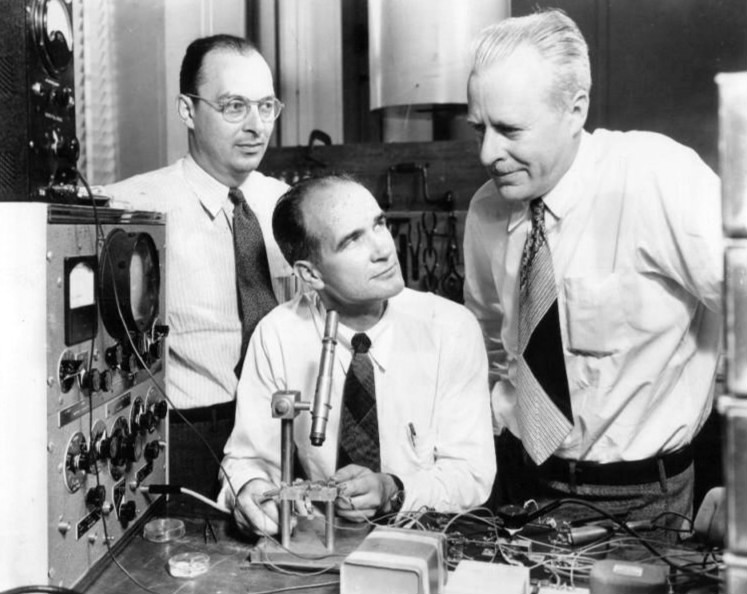 John Bardeen, William Shockley and Walter Brattain at Bell Labs, 1948.
John Bardeen, William Shockley and Walter Brattain at Bell Labs, 1948.
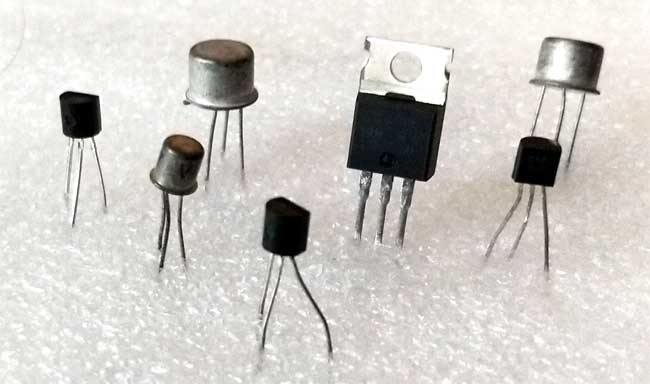 Picture of early solid-state transistors.
Picture of early solid-state transistors.
- 1949: EDVAC, the electronic discrete variable automatic computer was one of the earliest electronic computers. Unlike its predecessor the ENIAC, it was binary rather than decimal, and was a stored-program computer.
 The EDVAC Computer
The EDVAC Computer
- 1950: Shockley writes and publishes Electrons and Holes In Semiconductors.
- 1950: Univac is a line of electronic digital stored-program computers began at the Eckert-Mauchly Corporation. Later sold to and introduced by Sperry Rand a division of Remington Rand the typewriter manufacturer. The development of the Univac computer began in 1948 and was largely financed by the U.S. Census Bureau who used it to conduct the 1950 census. The Univac 1 became famous for successfully predicting the outcome of the 1952 Presidential election.
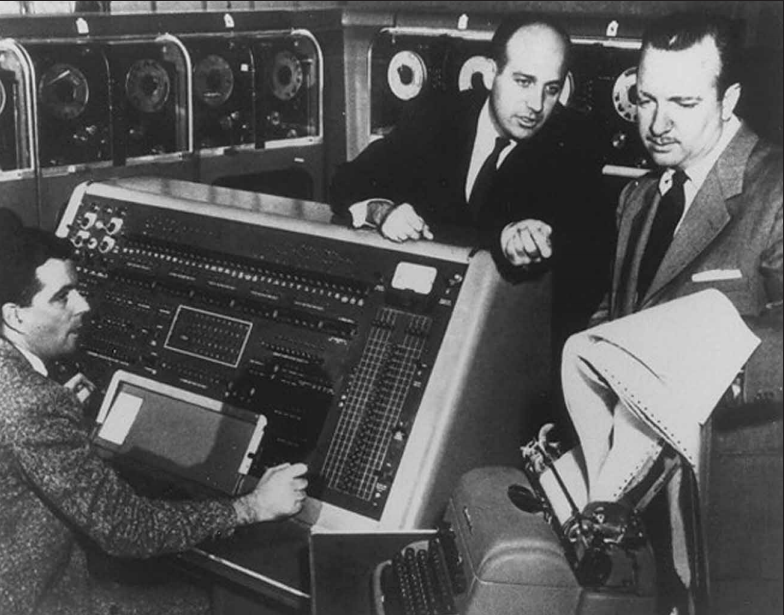 The Univac 1 used to predict the winner of the 1952 Presidential election. CBS Evening News anchor Walter Cronkite is reviewing the printed results being generated on a typewriter.
The Univac 1 used to predict the winner of the 1952 Presidential election. CBS Evening News anchor Walter Cronkite is reviewing the printed results being generated on a typewriter.
- 1952: The IAS computer was the first stored program computer. It was introduced by the Institute for Advanced Study in Princeton, New Jersey.
 John von Neumann standing beside the IAS computer.
John von Neumann standing beside the IAS computer.
- 1954: Bell Labs chemist Morris Tanenbaum was asked by William Shockley to see if transistors could be made using silicon, from group III-IV. Tanenbaum recorded a successful demonstration of the first silicon transistor in his logbook. However, Bell Laboratories did not draw attention to Tanenbaum's discovery publicly. The successful transistor had been constructed using a rate-growing process which was felt to be poorly suited to large-scale manufacturing. Diffusion processes, pioneered by Bell's Calvin Fuller, were seen as more promising. Tanenbaum became the team leader for a group studying diffusion's possible application to the fabrication of silicon transistors. In the meantime, Gordon Teal had moved to Texas Instruments, where he was essential to the organization of TI's research department. He also led its team of silicon transistor researchers. On April 14, 1954 he and Willis Adcock successfully tested and demonstrated the first grown-junction silicon
transistor. Like Tanenbaum, they used highly purified DuPont silicon. Teal was able to bring the silicon transistor to production. He announced the results and displayed the TI transistors on May 10, 1954 at the Institute of Radio Engineers (IRE) National Conference on Airborne Electronics, in Dayton, Ohio.
- 1954: Varian Associates becomes first business in SRI.
- 1954: Commodore Business Machines, Inc. founded by Polish immigrant and Auschwitz survivor Jack Tramiel.
- 1955: Shockley moves to Palo Alto to start Shockley Semiconductor a division of Beckman Instruments, Inc. with the goal of creating silicon transistors. (1996; Saxenian, Annalee; Regional Advantage; Harvard University Press).
- 1956: IBM division started in San Jose, CA and built first hard disk drives, IBM
305 RAMAC, beginning in 1957.
 By User RTC on en.wikipedia - Photo by U. S. Army Red River Arsenal, Public Domain, Link
By User RTC on en.wikipedia - Photo by U. S. Army Red River Arsenal, Public Domain, Link
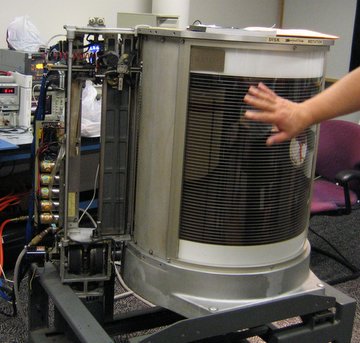 IBM 305 RAMAC disc drive. By vnunet.com, CC BY-SA 2.5, Link
IBM 305 RAMAC disc drive. By vnunet.com, CC BY-SA 2.5, Link
 Control Panel for IBM 305 RAMAC. This image visually demonstrating the "tyranny of numbers" problem created by the need to manually wire transistors to each other to build computational electrical circuits.
Control Panel for IBM 305 RAMAC. This image visually demonstrating the "tyranny of numbers" problem created by the need to manually wire transistors to each other to build computational electrical circuits.
- 1957: Traitorous eight (Gordon Moore, C. Sheldon Roberts, Eugene Kleiner, Robert Noyce, Victor Grinich, Julius Blank, Jean Hoerni and Jay Last) start Fairchild Semiconductor.
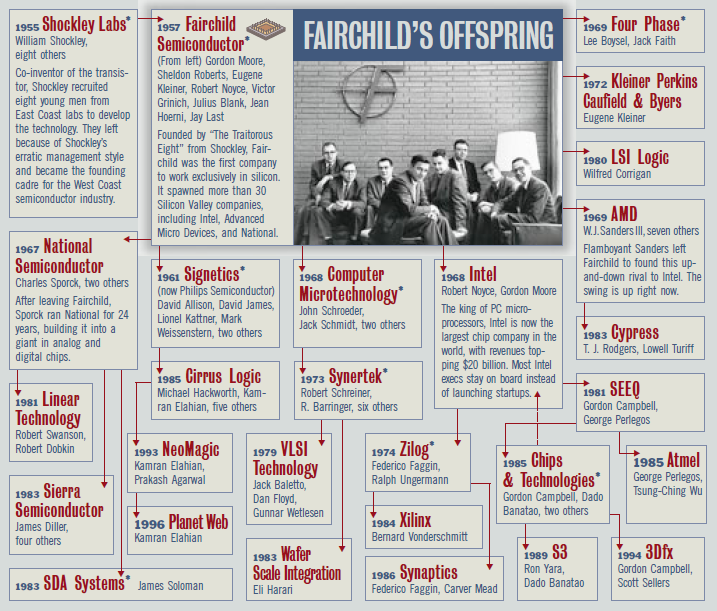 Chart showing the startups that where born as offshoots of Fairchild Semiconductor.
Chart showing the startups that where born as offshoots of Fairchild Semiconductor.
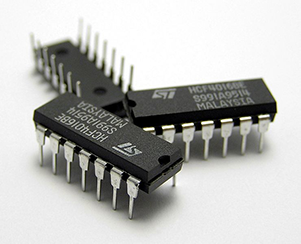 Integrated circuit chips.
Integrated circuit chips.
- 1958: In September, Jack Kilby invents the integrated circuit (IC) for Texas Instruments.
- 1959: Robert Noyce improves on Kilby's IC process.
- 1959: Digital Equipment Corporation (DEC) PDP-1 computer introduced. The PDP-1 (Programmed Data Processor-1) is the first computer in Digital Equipment Corporation's PDP series. It is famous for being the computer most important in the creation of hacker culture at MIT, BBN and elsewhere. The PDP-1 is the original hardware for playing history's first game on a minicomputer, Steve Russell's Spacewar!
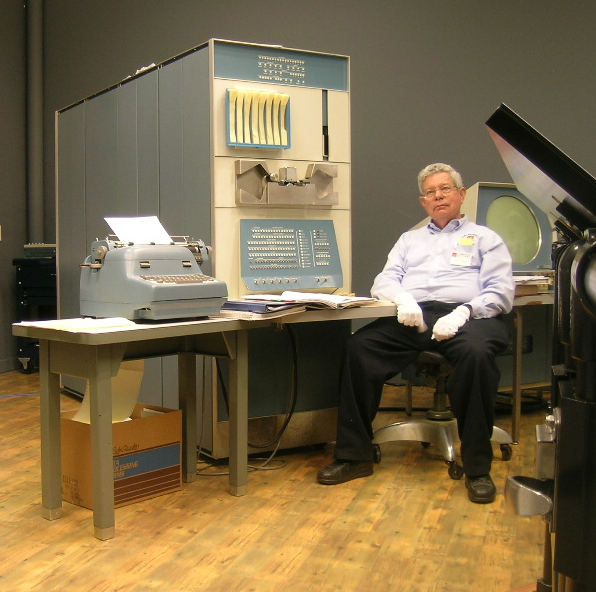 Steve Russell and the PDP-1.
Steve Russell and the PDP-1.
- 1960: The CDC 1604 was a 48-bit computer designed and manufactured by Seymour Cray and his team at the Control Data Corporation (CDC). The 1604 is known as one of the first commercially successful transistorized computers.
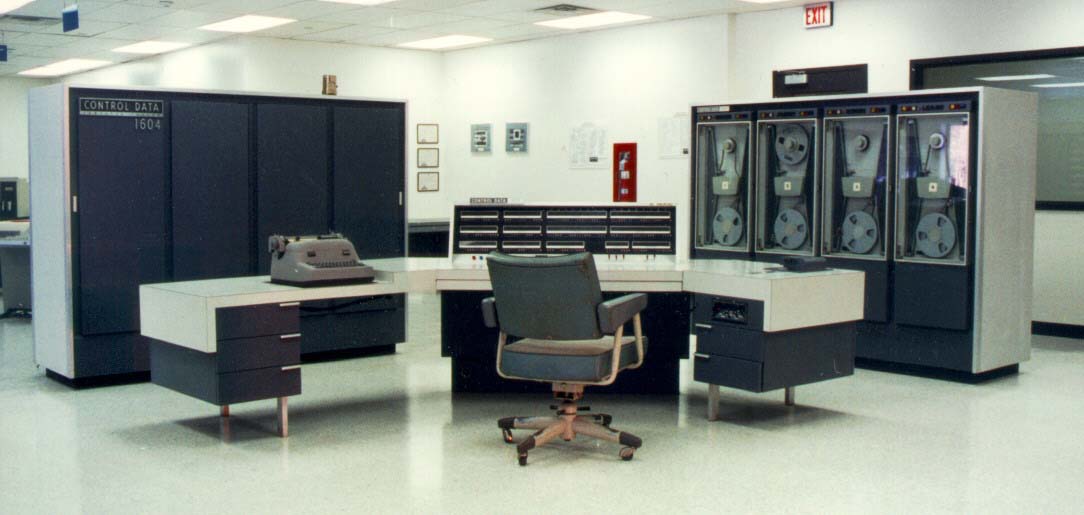 The CDC 1604, the first successfully transistorized computer.
The CDC 1604, the first successfully transistorized computer.
- 1968: (July 18) Intel was founded by Gordon Moore, Andrew Grove, and Robert Noyce. Originally was dedicated to making memory chips. Changed direction when market got overcrowded and developed the first microprocessor (see 1971 Intel 4004 chip).
- 1969: MOS Technology Inc. started by Allen-Bradley (brand name of a line of factory automation equipment manufactured by Rockwell Automation.
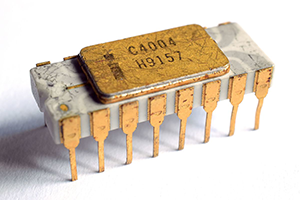 Intel 4004 Microprocessor
Intel 4004 Microprocessor
- 1969: (May 1) Advanced Micro Devices (AMD) is founded.
- 1971: The Intel 4004, the world's first microprocessor is introduced. Clock speed: 108KHz, Transistors: 2,300, Manufacturing technology: 10 Micron [1]
- 1972: Atari Pong released.
- 1972: Magnavox Odyssey is released as the first home video game console. Developed by Raph H. Baer at Sanders Associates it consisted of a white, black, and brown box which connects to a television set and two rectangular controllers attached by wires. it is capable of displaying three square dots on the screen in monochrome black and white, with differing behavior for the dots depending on the game played; it had no sound capabilities. One of the 28 games made for the system, a ping pong game, was the inspiration for the Atari Pong arcade game.
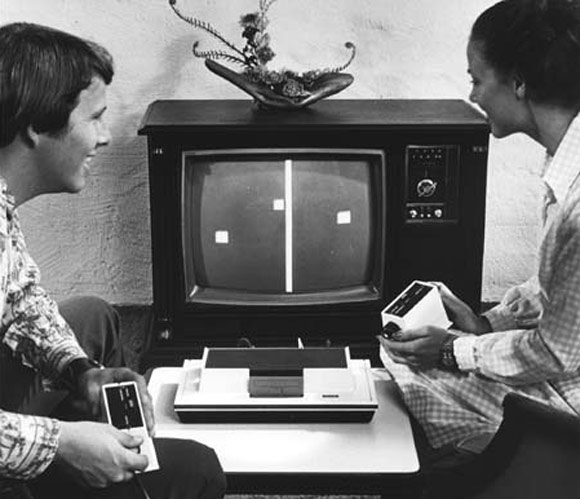 Pong on the Magnavox Odyssey game console.
Pong on the Magnavox Odyssey game console.
- 1972: The Intel 8008 ("eight-thousand-eight" or "eighty-oh-eight") is an early byte-oriented microprocessor designed by Computer Terminal Corporation (CTC), implemented and manufactured by Intel, and introduced in April 1972. It is an 8-bit CPU with an external 14-bit address bus that could address 16 KB of memory. Originally known as the 1201, the chip was commissioned by Computer Terminal Corporation (CTC) to implement an instruction set of their design for their Datapoint 2200 programmable terminal. Clock speed: 800KHz, 3,500 transistors, manufacturing technology10 micron [1].
- 1973: (March 1) Xerox introduces the Xerox Alto, the first computer designed from its inception to support an operating system based on a graphical user interface, to have mouse, to have networking capabilities. Based on a custom multi-chip central processing unit filling a small cabinet. Xerox only produced 2,000 units of the Alto which was sold for $40,000 per unit.
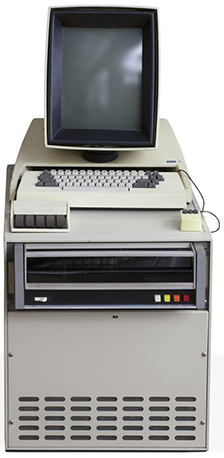
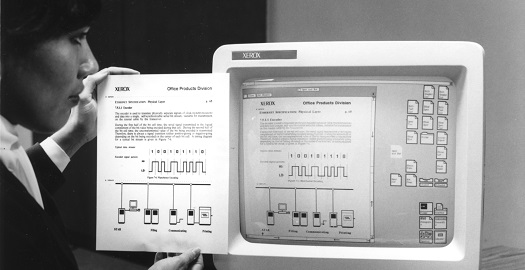 The Xerox Alto computer.
The Xerox Alto computer.
- 1973: Steve Jobs works at Atari on the assembly line.
- 1974: (April) The Intel 8080 8-bit microprocessor introduced. Clock speed: 2MHz, 4,500 transistors, manufacturing technology, 6 micron
- 1974: The Altair computer designed by MITS is based on the Intel 8080 CPU. The Altair is widely recognized as the spark that ignited the microcomputer revolution as the first commercially successful personal computer. The computer bus designed for the Altair was to become a de facto standard in the form of the S-100 bus, and the first programming language for the machine was Microsoft's founding product, Altair BASIC.
 The Altair 880 computer.
The Altair 880 computer.
- 1975: (April 4) Bill Gates and Paul Allen found Microsoft to develop and sell BASIC interpreters for the Altair 8800.
- 1975: MOS 6502 microprocessor introduced. It was the least expensive microprocessor on the market and spawned several home computers that were developed later, like the Commodore PET, Apple II, Commodore 64 and the Intellivision Entertainment Computer System (ECS).
- 1976: (April 1) Apple Computer Company founded by Steve Jobs, Steve Wozniak, and Ronald Wayne. The Apple I (in kit form) designed and engineered by Steve Wozniak, went on sale in July of 1976 and was market-priced at $666.66.
- 1976: Jack Tramiel of Commodore purchases MOS Technology Inc. a semiconductor design and fabrication company based in Norristown, PA.
- 1977: Commodore PET personal computer is introduced. Built around the MOS 6502 microprocessor.
- 1977: Warner Communication buys Atari for $30 million.
- 1978: The Intel 8086 16-bit microprocessor is introduced. Clock speed: 5Mhz, 29,000 transitors, manufacturing technology 3 micron
- 1978: The Apple II computer introduced. A preassembled computer with color graphics and popular spreadsheet software called VisiCalc. It was designed primarily by Steve Wozniak; Jerry Manock developed the design of Apple II's foam-molded plastic case, and Rod Holt developed the switching power supply.
- 1978: The Texas Instruments (TI) TRS-80 computer introduced.
 Byte magazines trinity of personal computers, the PET, the Apple II, and the TRS-80. Image courtesy of Boston-based collector Timothy Colegrove. For more information about this image send an email to timothy.colegrove@gmail.com
Byte magazines trinity of personal computers, the PET, the Apple II, and the TRS-80. Image courtesy of Boston-based collector Timothy Colegrove. For more information about this image send an email to timothy.colegrove@gmail.com
- 1979: (July 1) Intel 8088 microprocessor introduced. Data width: 8-bit, Address width: 20 bits, clock speed: 4.77 MHz, 29,000 transistors.
- 1979: Steve Jobs arranges a visit to Xerox PARC. Apple engineers used the concepts learned from Xerox to introduce the Apple Lisa, and later the Apple Macintoch.
- 1979: Atari 400/800 computer introduced.
- 1979: Motorola 6800 CPU introduced.
- 1980: The Commodore Vic-20 computer introduced.
- 1980: Texas Instruments (TI) 99/4 computer introduced.
- 1980: Sinclair ZX80 computer introduced.
- 1981: The IBM PC a.k.a Model 5150 — as it was known to the tech circle — came out in 1981 and ran the first version of Microsoft’s groundbreaking Disk Operating System (or MS-DOS), and with a 4.77 MHz Intel 8088 at its core and possible RAM expansions going up to 256KB, the PC was a beast of a machine. It also featured both monochrome and color graphics options to please those who needed either. Although far more expensive than the VIC-20, it was the be-all-end-all of microcomputers at the time of its release.
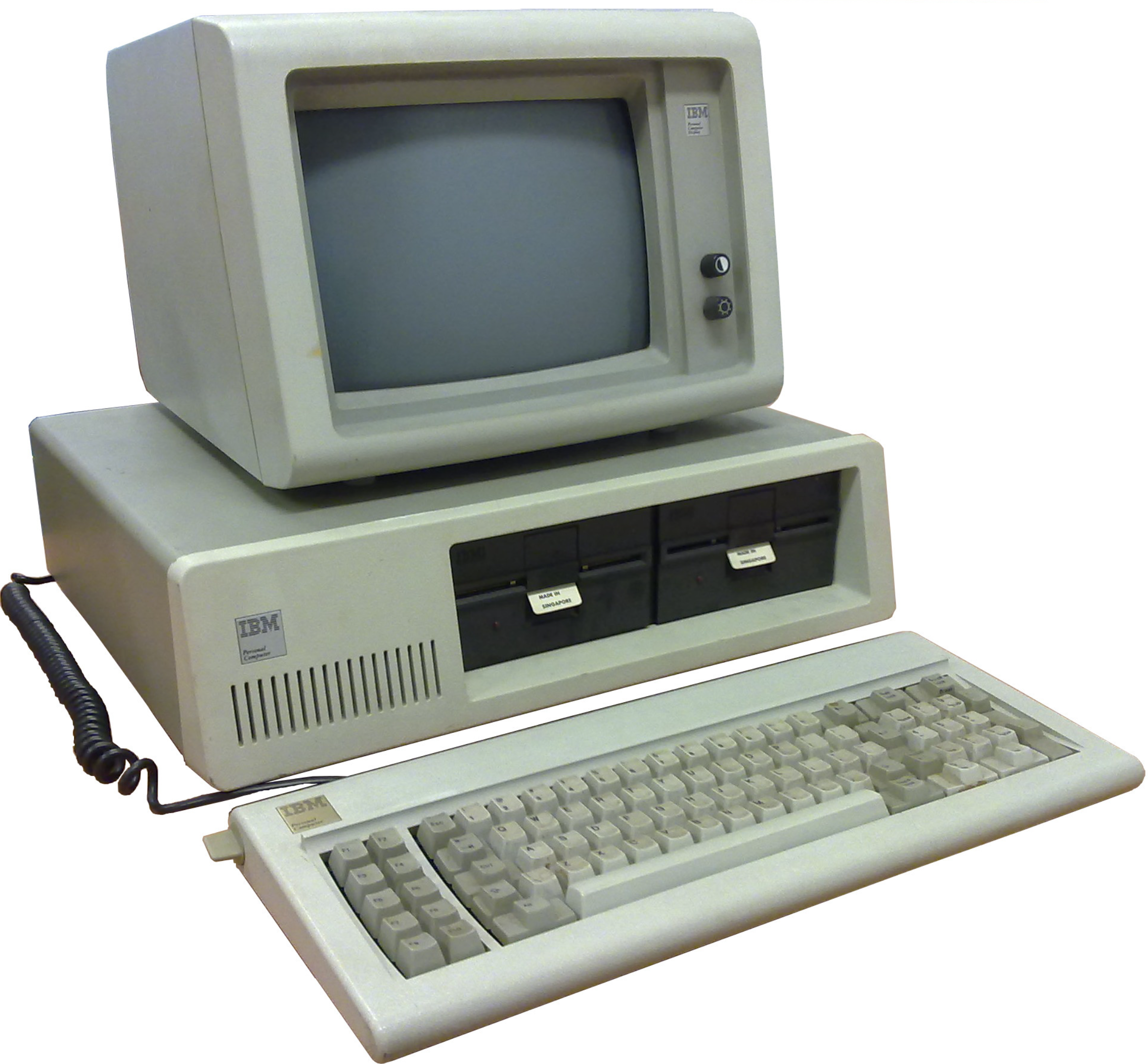 Click image for larger view.
Click image for larger view.
- 1982: Commodore 64 computer introduced.
- 1982: Sun Micro Systems founded.
- 1982: Date General founded by Gordon Bell.
- 1982: Compaq Computer Corporation founded by former Texas Instruments senior managers Rod Canion, Jim Harris, and Bill Murto.
Electronics Links of Interest
Basic Electronics Part 1 - Instructor Joe Gryniuk teaches you everything you wanted to know and more about the Fundamentals of Electricity. From the classrooms of Lake Washington Technical College in Kirkland, Washington.
Recommended Book for this course : Introduction to Electronics 6th Edition https://amzn.to/3IHU7RQ Author: Nerd's lesson
- Length: 10:48:57
What is Voltage - This video provides scholar's with an excellent explanation and demonstration of what voltage is.
- Length: 0:06:56
Electromagnetism - An explanation and demonstration of what electromagnetism is.
- Length: 0:05:28
Transistors - The Invention That Changed The World - This YouTube video uses narration and animation to illustrate what a transistor is and how they work.
- Length: 0:08:11
Transistors Tutorial - This is an outstanding tutorial explaining transistors, what they are, their different types, and how they work.
History of the Integrated Circuit - This description of the history of the integrated circuit (IC) comes from the official Web site of the Nobel Prize. It is an excellent and concise accountig of this important history in the evolution of data processing.
How Integrated Circuits Are Made - Interesting Web-based document explaining the process used to make integrated circuits.
How a CPU Works - This video demonstrates the inner workings of the "Scott" CPU, a fictitious CPU written about by J. Clark Scott in his book on how CPUs work.
- Length: 0:20:41
How CPUs Are Made - This YouTube video from Global Foundry shows the processes involved in creating a central Processing Unit.
- Length: 0:10:15
Hackster.io - This Web site has some great tutorials on creating electronic projects including Arduino projects.
⇑ Table of Contents